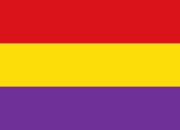Spanish National Liberation Front facts for kids
Quick facts for kids
Spanish National Liberation Front
Frente Español de Liberación Nacional (FELN)
|
|
|---|---|
| Founder | Julio Álvarez del Vayo |
| Founded | 1964 |
| Dissolved | 1970 |
| Merger of | Together with PCE (m-l) and Vanguardia Socialista gave origin to the Revolutionary and Patriotic Antifascist Front (FRAP) |
| Headquarters | Belgium and France |
| Newspaper | FELN and ¡Frente! |
| Ideology | Spanish republicanism Left-wing nationalism Anti-Francoism Revolutionary socialism Third worldism |
| Colors | Red, Yellow and Murrey (Spanish Republican colors) |
| Party flag | |
 |
|
The Spanish National Liberation Front (Spanish: Frente Español de Liberación Nacional), often called FELN, was a group from Spain. It was against the Francoist government and supported the idea of a Spanish Republic.
FELN was active between 1963 and 1970. Its main offices were located in Belgium and France. Julio Álvarez del Vayo was the person who started this group.
History of FELN
The FELN was created in February 1964. This happened after another group, the Communist Party of Spain (PCE), decided to stop its armed fight against the government. Some people, including Julio Álvarez del Vayo, disagreed with this decision. They wanted to keep fighting against the Francoist rule.
The FELN had two main goals:
- To continue the fight inside Spain.
- To do everything needed to remove the Francoist government.
The FELN was strongly against the Francoist government and supported the Spanish Republic. It was also against American influence, asking for US military bases in Spain to close. However, the Spanish police were very effective. They made it hard for FELN to grow or do much inside Spain.
FELN published two newspapers, FELN and ¡Frente!. These newspapers were printed simply.
In 1968, big student protests happened in France. These protests gave new ideas to the FELN. The group then joined with the Communist Party of Spain (Marxist–Leninist) and another small group called Vanguardia Socialista. Together, they formed a new, more active group called the Revolutionary and Patriotic Antifascist Front (FRAP). Julio Álvarez del Vayo became a leader in this new organization.
The Montenegro Case
The Spanish National Liberation Front was not very well known. However, in 1964, a case called the Caso Montenegro involved the FELN and made headlines in Spain. Even so, the name of the FELN group was not shared with the public in Spanish newspapers.
The most famous FELN member involved was Andrés Ruiz Márquez. He was known as Coronel Montenegro. He was a former soldier who was good at skiing. Starting on May 10, 1964, he placed small explosive devices, like large firecrackers, in different places in Madrid. Some of these explosions happened near government buildings, the American Embassy, and a hotel.
On June 23, the Spanish police arrested Ruiz Márquez in Madrid. He was carrying three of his firecrackers.
On July 7, Ruiz Márquez was sentenced to death by a military court. This trial became very famous as the "Caso Montenegro." People paid attention because the accusations against him seemed exaggerated. Later, his death sentence was changed to life in prison. He stayed in jail until 1977, two years after Franco died. He was one of the first people accused of serious actions like this to spend so long in prison.
See also
 In Spanish: Frente Español de Liberación Nacional para niños
In Spanish: Frente Español de Liberación Nacional para niños
- Revolutionary Antifascist Patriotic Front
- Organisation of Marxist–Leninists of Spain
- Tribunal de Orden Público
- Capital punishment in Spain

